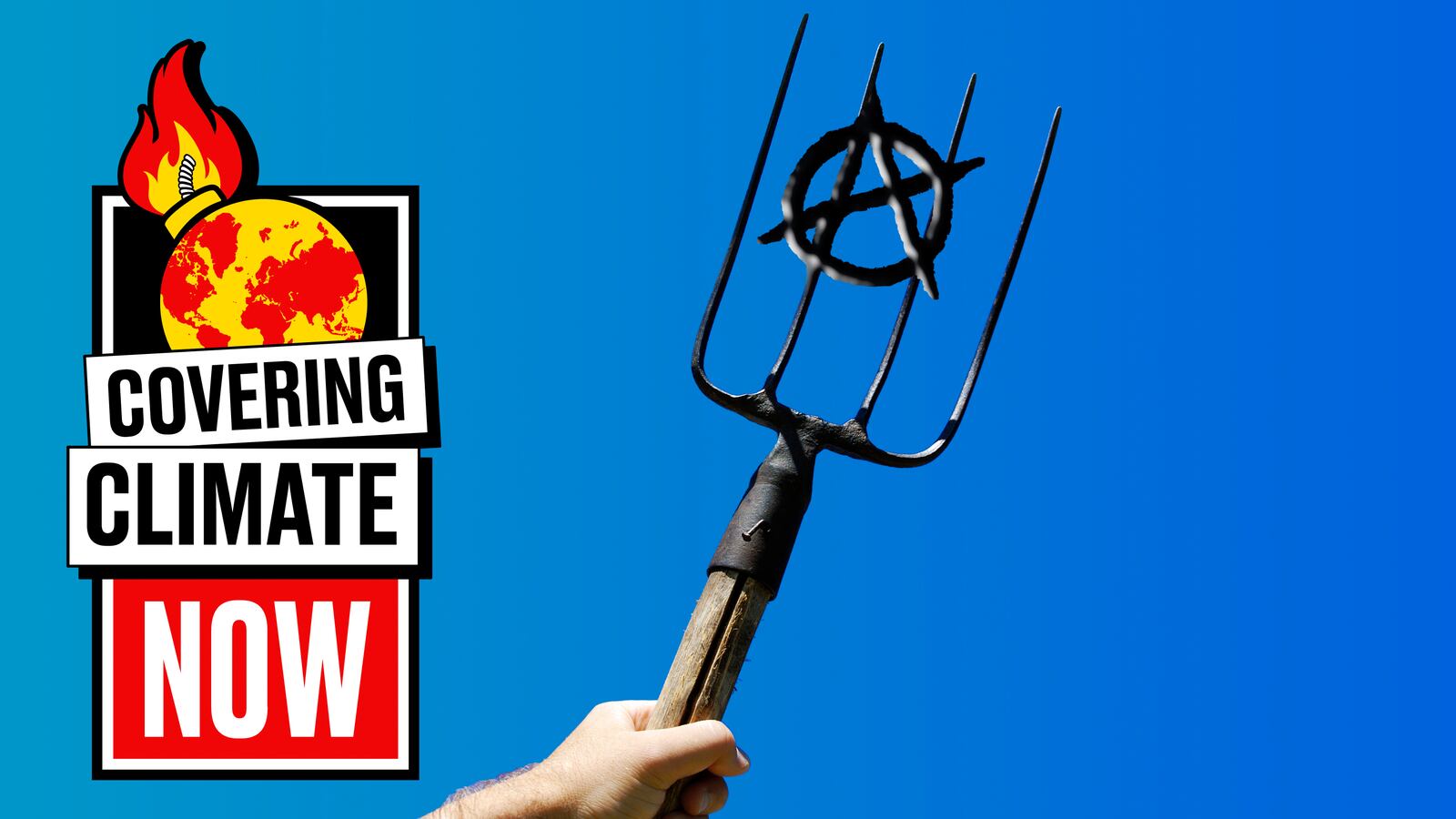This story is part of Covering Climate Now, a global collaboration of more than 220 news outlets to strengthen coverage of the climate story.
In the waning months of 2011, Tim Holland was deeply involved in Occupy Denver, the local arm of the international Occupy movement. The 41-year-old anarchist and hip-hop artist, who goes by the stage name Sole, had been living in the Mile High City since 2009. When Occupiers first set up an encampment at Lincoln Park, Holland organized street protests, public assemblies, fundraisers, reading groups, and more. Protesters interrupted city council meetings and repeatedly attempted to take over government buildings before the movement was quashed when their second encampment in Civic Center Park went up in a haze of flames. Following Occupy Denver’s suppression by law enforcement, gentrification in the city seemed to shift into hyperdrive, forcing Holland to rethink living there.
“I wanted to pull myself out of the rat race and reimagine what a new form of my political interventions and practices could be,” he said.
Holland had visited intentional communities in France, where radicals were successfully supporting themselves through farming. The idea of anarchists in North America doing the same captured his imagination. He left Denver in 2018, relocating with his wife and young child to an old farmhouse on the outskirts of Brunswick, Maine.
“Earlier in the year that I moved, I learned about the Ogallala Aquifer, which feeds all of the farmland of the breadbasket—and Colorado as well,” Holland said. “It’s going to be depleted in 20 years from now.” Wanting to reorient his life and politics around “food autonomy”—or self-sustaining food production—Holland saw the depletion of the Ogallala Aquifer as not only a strike against staying in Denver but grim proof of what awaited much of American society, which depends on conventional food production to survive.
The dire threat that climate change poses to conventional food production in the United States has been anticipated for years. In a 2012 report, the U.S. Department of Agriculture predicted that post-2050 most crop and livestock production would suffer from a combination of rising temperatures, variable precipitation, and more frequent extreme weather events, such as droughts or floods. The USDA anticipates that, even in the short-term, these effects will exacerbate hunger among the poorest and most vulnerable.
For anarchists like Holland, the anonymously written text Desert was a wake-up call. The 80-page zine, published both online and in print in 2011, argues that the inevitability of climate change will lead to widespread desertification, which governments are incapable of preventing. As extreme as that may sound, Holland felt that he could see the writing on the wall, even from the relative privilege of Denver.
If Desert’s diagnosis rang true, so too did its prognosis. The text’s author suggests that while the consequences of climate change are unavoidable, anarchists may yet prevail against both capitalism and the state. Positing that desertification will cause both markets and governments to retract, Desert argues that in their absence, anarchists could thrive—if only they could first survive.
“In this metaphor of the desert, where does life emerge?” Holland wondered. “If we end up unable to create some mass movement to overthrow the government, what does it look like to build a material force capable of sustaining itself, capable of struggle, capable of being the grounds that make government obsolete?”
In Brunswick, Holland is beginning the search for answers. These days, Holland commits much of his time to gardening, but doesn’t see it as a step away from his anarchist politics. Rather, he sees it as a step forward.
On an acre and a half of land, his budding interest in gardening blossomed into greater study and practice of permaculture, a form of agriculture that emphasizes the creation of sustainable ecosystems with minimal need for external resources, such as fertilizer. With only the occasional help from family and friends, he has cleared half the land of brush, planted 100 fruit, nut, and berry trees and shrubs in addition to a variety of greens and root vegetables. Holland has managed to eek out some staples like lettuce and tomatoes, but has had greater success with perennials like hablitzia, Turkish rocket, and asparagus chives. He’s also learned to forage for berries and wild greens, such as raspberries and sorrell. Many of the plants will take years to mature, especially the fruit trees, but his efforts are already providing daily salads and he expects to harvest hundreds of pounds of carrots, potatoes, and pumpkins.
Although Holland has been unable to provide all of his family’s food, he says that’s not necessarily the goal. (“If I had been living off the land, 100 percent I would have died this year,” he joked.) Belief in the anarchist ideal of mutual aid, which encourages sharing and cooperation to build collective strength, led Holland to think beyond his family. To that end, he has been forming a network across his new home state.
“I’ve been coming into contact with lots of radical farmers in Maine,” he said, “and it’s exciting to think what kind of good could come from farming networks based on mutual aid and solidarity.”
Reaching out to neighbors and other local agricultural enthusiasts, Holland has been able to learn how to deal with Maine’s unfamiliar soil, which plants can thrive in the short growing seasons, and even how to tap trees for maple syrup. The ad hoc network has not only quickly gotten him up to speed with his new surroundings, but given him a way to share the results of his own experiments in permaculture, like which perennials can survive a cold snap or the best ways to cook with unfamiliar vegetables. The exchanges between farmers include seeds and plants, but also ideas, like extending the growing season with greenhouses or the basics of herbal medicine.
“It’s an idea that I’m actively working on and talking about with other people I've met,” Holland said of creating a mutual aid farming network in Maine. “But if anything, I have more questions about where to go with it, than I have a fixed idea in my head. So for me, it’s about getting a lay of the land here, getting to know people — not spinning my wheels trying to impose solutions on a place I still don't fully understand.”
While Holland’s efforts are still in their early stages, others like Inhabit are further along. The project, which appeared both online and in book form in 2018, was collectively produced by 50 participants over the course of three years. It declines to describe itself as anarchist—37-year-old participant Sean Heizner, said Inhabit is “from the left, but not of the left”—yet has a somewhat similar approach. The project advocates that radicals find each other and create hubs of self-sustenance, such as collective farms, in order to provide for themselves in the wake of climate change.
To help create and connect those hubs, Inhabit is building networking tools for hundreds of radicals across North America. Its newsletter, for example, shares resources, lessons, and experiences related to everything from permaculture to computer programming.
“Each is devoted to building communal bonds and autonomous infrastructure that meaningfully changes people's experience of their territories,” said Heizner of the hubs.
Tucker Lang is a participant in one of Inhabit’s hubs. A 26-year-old engineer in South-Central Indiana, Lang—like Holland—was also deeply inspired by the Occupy movement. He discovered Inhabit while travelling through the United States “in search of a different way of life,” as he put it.
“I found a diffuse constellation of projects—maker spaces, urban farms, bike repair collectives, sustainable builders, ecovillages, art venues, DIY spaces, intentional communities, and so many other forms of life, all with the similar trajectory of taking control of their lives,” said Lang of Inhabit. “The network is what gives me strength, knowing that there are many people in many places fighting and building.”
Like Holland, Lang also purchased a farm two years ago. It’s 10 and a half acres, although mostly wooded, with only an acre of usable farmland. With the aid of friends and family, he is mostly growing garden staples, such as tomatoes, cucumber, squash, lettuce and other greens. But rather than focusing on producing food for consumption, Lang is interested in using his farm to conduct research and experiments into improving growth rates and yields, the results of which he can share through Inhabit. He is currently working on a project collecting and diverting rainwater through a system of ponds.
Connecting people working on complementary projects in the hopes that they will materially support each other, as Holland and Inhabit are doing, may seem like a small thing compared to the scale of challenging the state or surviving climate change. But their aims are not to abandon the city for the country, to build a farm-turned-fortress for a single family to weather out global warming. If the goal is collective self-sustenance, then it is imperative to build relationships with like-minded people.
As Holland points out, “going back to the land” for anarchists means more than simply farming; it entails understanding the places where they live, from the nature to the neighbors.






